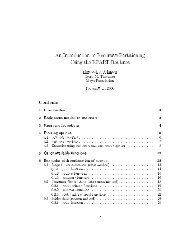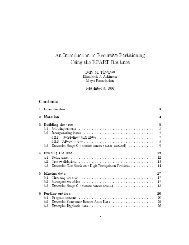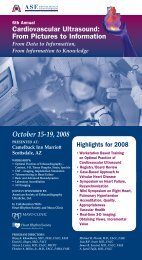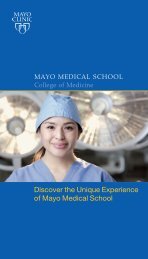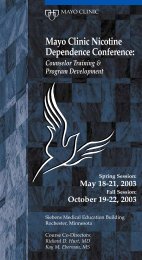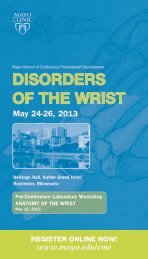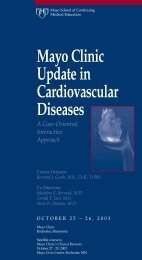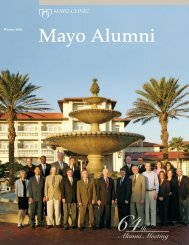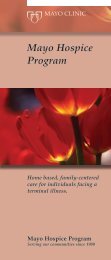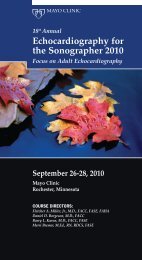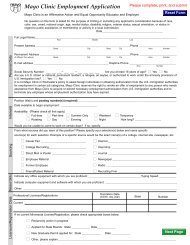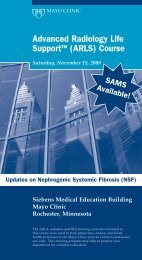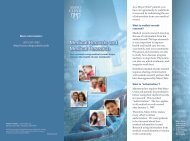Mayo Alumni Magazine 2002 Spring - MC4409-0402 - Mayo Clinic
Mayo Alumni Magazine 2002 Spring - MC4409-0402 - Mayo Clinic
Mayo Alumni Magazine 2002 Spring - MC4409-0402 - Mayo Clinic
Create successful ePaper yourself
Turn your PDF publications into a flip-book with our unique Google optimized e-Paper software.
<strong>Mayo</strong> Update<br />
Obituaries<br />
1940s<br />
Gerald Ahern, 87, died Dec. 11,<br />
2001. Dr. Ahern received his medical<br />
degree in 1939 from the University of<br />
Minnesota. After a residency in<br />
Bismarck, N.D., Dr. Ahern completed<br />
a fellowship in orthopedic surgery in<br />
1948 at <strong>Mayo</strong> <strong>Clinic</strong>. He served as a<br />
commissioned officer in the United<br />
States Army Medical Corps Reserves<br />
and was called to active duty in 1942,<br />
serving in Adak, Alaska, in the<br />
Aleutian Islands, until 1945.<br />
Dr. Ahern served in medical practices<br />
in Albuquerque, N.M., and Fargo,<br />
N.D., before joining a private practice<br />
in Corpus Christi, Texas, in 1964. He<br />
served as chief of orthopedics and<br />
chief of staff at Memorial Medical<br />
Center. Dr. Ahern began to focus his<br />
practice on surgery of the hand<br />
during this time. In 1977, he moved<br />
to Kerrville, Texas, where he became<br />
chief of orthopedics at Veterans<br />
Hospital. He was appointed clinical<br />
associate professor of orthopedic<br />
surgery at the University of Texas<br />
Health Science Center in<br />
San Antonio. He retired in 1988.<br />
Juan Nesi, 92, died Aug. 5, 2001.<br />
Dr. Nesi received his medical degree<br />
in 1932 from the Universidad<br />
Nacional de Buenos Aires in<br />
Argentina and later completed a<br />
fellowship in anesthesiology at <strong>Mayo</strong><br />
<strong>Clinic</strong> in 1941. He worked as an<br />
anesthesiologist in Buenos Aires and<br />
as a professor of anesthesiology<br />
Universidad Nacional de Buenos<br />
Aires until 1957 when he became a<br />
professor of anesthesiology at the<br />
Hospital Universitario de Caracas,<br />
Venezuela. He later served for 25<br />
32 <strong>Mayo</strong> <strong>Alumni</strong> <strong>Spring</strong> <strong>2002</strong><br />
years as professor on the faculty of the<br />
Universidad Central de Venezuela. He<br />
retired in 1985.<br />
1950s<br />
Raymond Courtin, 89, died Dec. 30,<br />
2001. Dr. Courtin received his medical<br />
degree from St. Thomas Medical<br />
College in London in 1935. He entered<br />
the Royal Air Force upon graduation<br />
and served as a medical officer<br />
through the end of World War II. He<br />
received the Member of British Empire<br />
award from King George VI at the end<br />
of his military service. Dr. Courtin<br />
completed a fellowship in<br />
anesthesiology in 1950 at <strong>Mayo</strong> <strong>Clinic</strong><br />
and joined the staff. He later became<br />
an American citizen. He left <strong>Mayo</strong><br />
<strong>Clinic</strong> in 1954 to become chief of<br />
anesthesiology at Baylor Medical<br />
Center in Dallas. In 1977,<br />
Dr. Courtin and his wife, Jean,<br />
organized and directed a pain clinic in<br />
Dallas, until he retired in 1988.<br />
Henry Dodge, 83, died Sept. 9, 2001.<br />
Dr. Dodge received his medical degree<br />
in 1943 from the College of Physicians<br />
and Surgeons, Columbia University.<br />
He served in the Medical Corps of the<br />
United States Army during World War<br />
II and was the head of the United<br />
States Army’s team that reviewed<br />
atomic bomb casualties in Hiroshima<br />
and Nagasaki, Japan. Dr. Dodge<br />
completed a fellowship in<br />
neurosurgery at <strong>Mayo</strong> <strong>Clinic</strong> in 1951<br />
and joined the <strong>Mayo</strong> staff. He left<br />
<strong>Mayo</strong> <strong>Clinic</strong> in 1958 and had a private<br />
practice in Los Angeles. Dr. Dodge<br />
also was on staff at St. John’s and<br />
St. Vincent’s in Los Angeles and taught<br />
anatomy at the University of Southern<br />
California. He retired in 1995.<br />
Virginia Hartridge, 82, died Nov.<br />
22, 2001. After receiving a master’s<br />
degree in public health from the<br />
University of Michigan in 1942, she<br />
became an officer and director of a<br />
laboratory of immunology in the<br />
Army’s Women’s Medical Specialist<br />
Corps from 1943 to 1946. After World<br />
War II, she received her medical<br />
degree in 1950 from the Woman’s<br />
Medical College of Philadelphia.<br />
Dr. Hartridge completed her residency<br />
in anesthesiology at <strong>Mayo</strong> <strong>Clinic</strong> in<br />
1956 and joined the <strong>Mayo</strong> staff that<br />
year and was the first woman<br />
consultant in the Department of<br />
Anesthesiology. Dr. Hartridge also<br />
served as director of the <strong>Mayo</strong> <strong>Clinic</strong><br />
School of Nurse Anesthesia. In 1980,<br />
she was named an associate professor<br />
of anesthesiology at the <strong>Mayo</strong> Graduate<br />
School of Medicine and <strong>Mayo</strong> Medical<br />
School. She retired in 1982.<br />
1960s<br />
Charles Salamone, 69, died Oct. 30,<br />
2001. Dr. Salamone received his<br />
medical degree in 1958 from Marquette<br />
University Medical School and<br />
completed his fellowship in neurology<br />
at <strong>Mayo</strong> <strong>Clinic</strong> in 1963. He joined a<br />
private practice in Rochester, N.Y., in<br />
1963. He lived and worked in<br />
Rochester, N.Y., until his death.<br />
1970s<br />
Edward Harder, 58, died Feb. 3,<br />
<strong>2002</strong>. Dr. Harder received his medical<br />
degree in 1968 from the University of<br />
Alberta in Edmonton, Alberta, Canada.<br />
He completed fellowships at <strong>Mayo</strong><br />
<strong>Clinic</strong> in internal medicine in 1971 and<br />
infectious diseases in 1973. He then<br />
practiced in Wyoming, Canada and<br />
Saudi Arabia before moving to<br />
Lexington, Ky., where he became an<br />
associate professor of medicine at the<br />
University of Kentucky, and was active<br />
in the university’s bone marrow<br />
transplant services. Dr. Harder later<br />
joined Lexington Infectious Disease<br />
Consult-ants, where he worked until<br />
his death.



